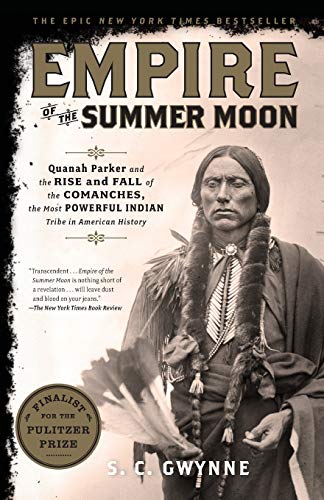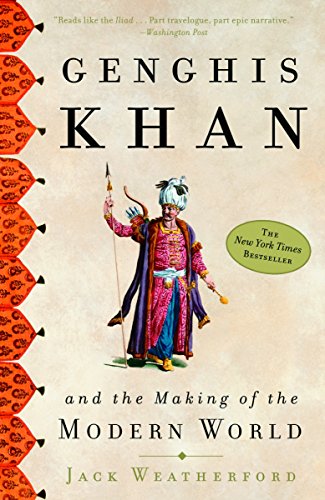
The Worlds Greatest Horse Warriors
In this double-review we will look at two books that share one common quality: These two cultures were undoubtedly the best horse warriors in the world. But, that is where the comparison ends.
The first book, though from a more modern perspective, is the best place to start.
That book is “Empire of the Summer Moon – Quanah Parker and the Rise and Fall of the Comanches, the Most Powerful Indian Tribe in American History”.
When I ordered the book I checked the reviews. Nearly all were very good but there was some criticism by a couple of native reviewers who believed the book to be too Eurocentric. That may be a fair critique. However, it appears to me that the author, S.C. Gwynne, did a fairly balanced description of the atrocities committed by both Native Tribes and European Americans.
This was a tough, shitty time for all involved.
The story revolves around Quanah Parker, the mixed-race son of a captured white woman and a powerful Comanche warrior. The historical capture/kidnapping was the inspiration for the filming of the controversial western movie starring John Wayne called “The Searchers”.
The actual searcher was James Parker, who logged in some five-thousand miles trying to locate his niece Cynthia Ann Parker (who became Quanah’s mother) and two young boys.
The story of Quanah is somewhat of a difficult, situational evolution of a man who would be the final Comanche Chief, and later worked closely with white officials to try and improve the fate of various tribes that were defeated and forced onto reservations.
What was fascinating to me was how incredibly powerful the Comanche tribe was as far as preventing western expansion, and how their skill with horses and knowledge of the environment was unparalleled.
In this narrative, the Comanche’s were experts at both stealing horses from Spanish explorers, and they mastered the process of horse-breeding. Horses revolutionized the plains Indians, and allowed them skill in combat and the ability to track and kill Buffalo. Young Indian boys and men did very little work in camp, they mostly practiced hunting and fighting from horseback. In doing so, along with their environmental knowledge, they were far superior to European settlers who struggled in the desert southwest.
Perhaps the star of the show here are the Indian ponies, descendants of stolen Spanish horses. At the end of this review we will speculate about the original origin of these ponies, and I will put forth a theory that they are also descendants of the steppe culture ponies used by the Mongol warriors.
Here’s what made the Comanche fighting style so successful; their ponies were durable, agile, and capable of long marches on little fuel. The Comanche would fight with lance and arrow, running spectacular maneuvers that dazzled the European settlers. The attacks by both sides were bloody and brutal, with torture involved. Comanches fought to the death against other tribes as well, to avoid torture that would follow capture.
By comparison, the European horses could carry heavy loads at speed for short distances, but would “burn out” trying to keep up, leaving the riders facing sure death as the Comanches caught them by surprise.
Additionally, the Europeans fought using old-style long rifles, which were not at all accurate from horseback. The close-range blitzes by Comanches were superior tactics, with a quick get-away into the barren, rocky wilderness.
As the Civil War developed, no regular Army was left to guard settlements on the western frontier – and insure the theft of Indian lands.
Here we see what may have happened to Texas, and why the rest of the country sees Texans as an anomaly, or aberration. Texas was never developed on a parallel track with the rest of the country.
The lack of Army support led to the development of The Texas Rangers, the most famous perhaps being a man named Jack Hayes.
The Rangers, at least the first generation, were truly amazing. They learned to fight the Comanches Indian-style, adopting the Comanche tactics. This was a real problem for the Comanches, as well as the Mexican raiders from the south.
The Rangers also adopted the Colt six-gun, very deadly at close range.
But the author explains that in subsequent years, the Rangers were mostly thrill-seeking drunks and murderers.
The white culture, in it’s drive towards genocide, rationalized that killing off all the Buffalo was the most effective way to seize western land. That’s exactly what happened.
For all their skill on the plains, the Comanche’s rejected food cultivation (used by other tribes) and some tool use. This lack of ability to adapt appears to be part of their downfall.
With the Buffalo gone, the nomadic tribes had little left but to be slaughtered and led to reservations.
It’s a terribly tragic story, with an interesting ending.
Quanah Parker, the mixed-race, powerful Chief was relentless in bargaining with the dominant white culture to better his people with status and supplies. The west was changing, and Quanah changed with it, but on his own terms.
I will leave the rest for future readers.
Next, we review a great book about The Mongol Empire, the other, much older version of horse warrior culture.

While I loved “Empire of the Summer Moon”. I was simply blown away by “Genghis Khan and the Making of the Modern World”, by Jack Weatherford.
Weatherford lived in and around Mongolia, and has written a somewhat revisionist history of what many people consider the most brutal raiders in the ancient world.
I simply did not know how much the Mongols achieved in a short period of about a hundred years, beginning around the year 1200.
Much, but not all of Weatherford’s research draws upon a famous once-hidden book on the history of the Mongol empire. As legend has it, the “Secret History of the Mongols” was suppressed during Communist occupation, to prevent nationalistic rebellion in Mongolia and their former conquered neighbors.
Linking with the previous book on the Comanche’s, Mongol boys were trained to be expert horsemen, perhaps the best the world has ever seen. But that is where the comparison ends.
Mongol history revolves around the fantastic success of the man who would be called “Genghis Khan”, which loosely translates to “Unbreakable King”.
Nomadic steppe culture was very hierarchical, and when he gained power, Genghis removed aristocratic privileges, respected all religions, and created a more egalitarian balance from the brutal nomadic past.
I studied this book like a textbook. The horse tactics used by the Mongols were brilliant, so much so that they have been studied by nearly every other Calvary. The Mongols relied on hit-and run attacks, leading their enemies deep into the wilds, wearing them out and leaving them vulnerable to attack.
As they became more successful, they would lay siege to fortified castles, cutting down forests to build enclosures around them, waiting them out. In at least one case they diverted an entire river to flood out an enemy.
The Mongols never really invented or created technology above nomadic levels. They did however, adopt every type of weapon technology they could obtain from neighboring kingdoms like the Chinese or Persians. They build huge catapults and used Chinese gunpowder and fire bombs. Their machines could hurl huge rocks and logs at fortified walls, terrifying their victims. They traveled in great caravans, like a moving city. As they went, they first seized pasture for their all-important horses, and food animals for butchering. They could survive on muddy water, fermented mares milk and trapped or hunted vermin. More “civilized” societies had never, ever seen anything like the Mongols.
As stated, the Mongols created a more egalitarian outlook for their people, as well as those they ultimately conquered. Rather than all the loot going to the Khan, it was more equally divided among the Mongol tribes. Cultures they conquered payed tribute or were killed, but in the end, they all benefited from the spread of technology, free practice of religion, and the general advancement of all people. For example, Mongol women often managed the empire at home, while the fighting men were ranging across Asia, into Russia, to the Mediterranean, and into Persia and Baghdad.
Scholars have said that the middle-east, home to the most advanced medicine, science and technology at the time, never, ever recovered from the raids of the Mongol Empire.
All the while, as European emperors were quite busy burning and torturing heretics, the Mongols (while killers) did not torture average victims.
They did, however, experience various forms of palace intrigue over the course of many generations.
What ended the Mongol Empire was the plague. Everywhere they traveled on trade routes, they picked up and spread the plague. But in the preceding years, the Mongols conquered the known world, created paper money, legendary trade routes, liberalized religious practice, and spread technology.
I loved this book, and learned quite a lot from it. There is simply too much to include in this review.
———————–
Both “Empire of the Summer Moon” and “Genghis Khan and the Making of the Modern World”
are wonderful, informative reads.
Here is what may be the only comparison between the two cultures: the horses.
Both the Comanches and the Mongols used smaller, agile ponies. These horses repeatedly outperformed both European and Arab horse stock.
This led me to take a brief look at the origin of what became the Spanish Mustangs. While I could not find conclusive evidence, and the internet is rife with horse speculation, it is known that the Spanish horses apparently evolved from Indo-European steppe ponies, much like those used by the Mongols.
If my speculation is correct, the two best horse warrior cultures to ever ride the earth used ponies from similar genetic stock.
Both “Summer Moon” and “Genghis Khan” are highly recommended reading. I learned a ton about the American plains Indians, the crazy western expansion that the Comanches prevented for a generation, and the unusual history and the development of Texas.
And, while I knew about the extent of the Mongol Empire, I had no idea about how much they developed society as they raided their way across Asia and Europe.
And perhaps one key to the success of both cultures were the horses.
-John Titus


I’m half way through a reading of the Empire of the Summer Moon. Having been raise in Texas, less than 100 miles from the site of the original Parker’s Fort. One of my parents’ best friends when I was a child was a writer/history by the name of Benjamin Capps, himself a historian of the American West of significant note. As a result, stories about the Comanches were abundant throughout my childhood.
What I find most interesting with the Comanches was their use the horse as a form of technology.
Their mastery of riding and breeding of the horse, particularly for military purposes, was a skilled use of technology that allowed an otherwise technologically unsophisticated tribe to become the most powerful and dominant Indian culture in the history of the American West.
The Comanches ruled the Great Plains from the back of a horse; controlling an area that extended from modern day Dallas, TX to the eastern foothills of the Rockies, north to present day Kansas, south across central Texas and into eastern/southern New Mexico.
The geography and climate of this area made it a challenging place to live must less to flourish. Lesser men and women have tried and failed both before and after the reign of the Comanches.
Their military dominance of the Great Plains was no small feat for a nomadic tribe of hunter gathers with little in the way of a tradition social structure. In so doing they changed the course of history in ways that most Americans have never contemplated.